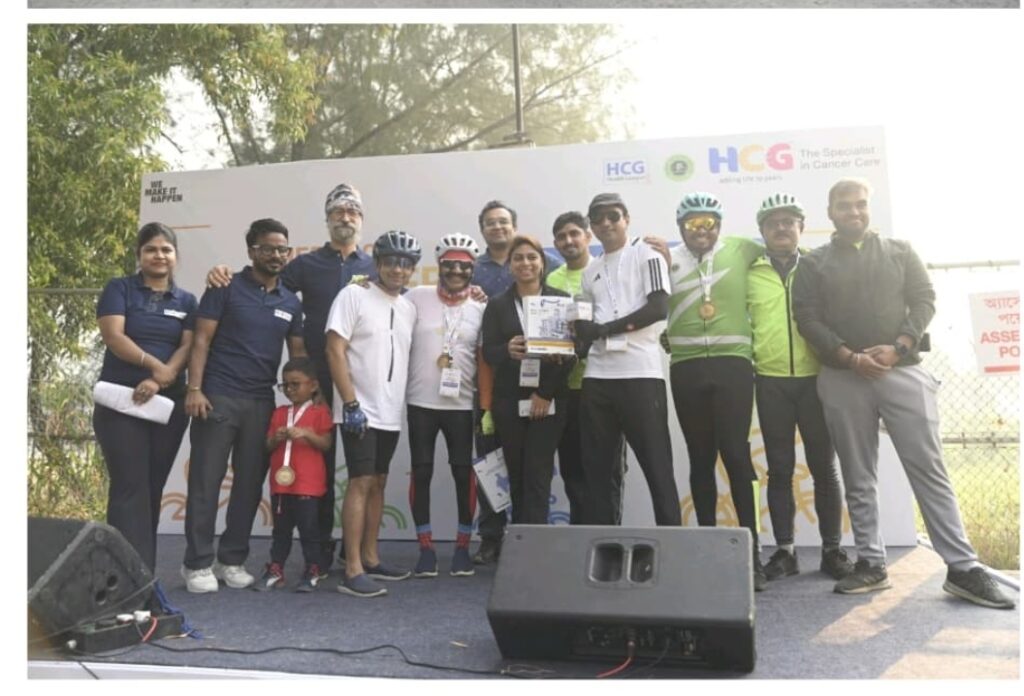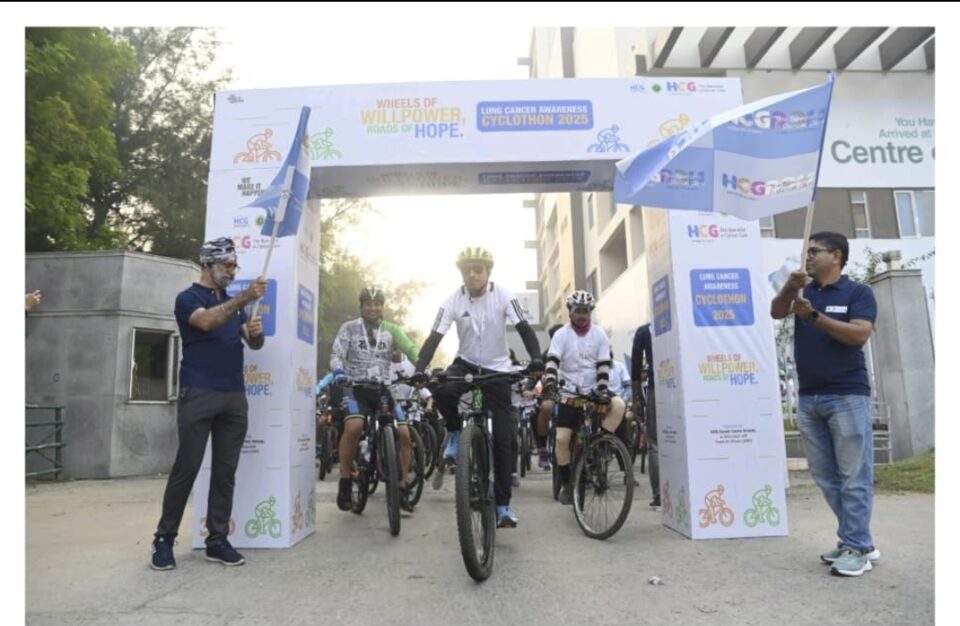Lung cancer awareness events do more than fill calendars. They quietly reshape how people experience healthcare, trust providers, and act on early warning signs. When a hospital moves outside its walls and rides with the community at 5 a.m., it also rewrites expectations of what “care” should feel like.
HCG Cancer Centre, Kolkata’s Cyclothon 2025 is one such moment. It looks like a fitness activity on the surface. In reality, it is a live, open-air CX and EX lab for preventive oncology, community trust, and behaviour change.
From hospital-centric to community-centric care
In India, lung cancer incidence and mortality are rising, with cases projected to reach more than 80,000 among men and 30,000 among women by 2025. Most patients still present at advanced stages, where 80–85% are incurable. This is not just a clinical problem; it is a customer experience problem rooted in late awareness, fear, and fragmented touchpoints.
Cyclothon 2025 places HCG physically in the community’s daily life instead of waiting for people to walk into OPDs. A 20 km ride across New Town, involving over 250 cyclists, transforms the brand from a distant cancer hospital into a visible ally on the road, literally and emotionally. The move from “come to us when unwell” to “we come to you when you are well” is the core mindset shift.
Event overview through a CX lens
On November 27, 2025, HCG Cancer Centre, Newtown, Kolkata, organised a Cyclothon to mark Lung Cancer Awareness Month. The ride brought together residents, organised cycling communities, senior doctors, and hospital leadership. The cyclists flagged off and returned at HCG Cancer Centre, covering close to 20 km across New Town and nearby routes, turning the campus into both a starting line and a health engagement hub.
Post-ride, the experience did not end with refreshments and photo-ops. Participants joined a lively Zumba and workout session by Zephyr & Team, followed by a focused health talk on lung cancer symptoms, risk factors, and screening options. This blended design—movement, motivation, and medical insight—kept the day anchored in preventive care, not only in recreation.
Humanising cancer conversations in public
For many people, lung cancer conversations begin only when someone is seriously unwell. That naturally loads the patient journey with fear, guilt, and regret. Dr Sanchayan Mandal, Senior Consultant – Medical Oncology at HCG Cancer Centre, Kolkata, highlighted how early lung cancer symptoms often resemble common respiratory infections. Many individuals therefore delay seeking care, assuming it is “just a cough” or pollution-related discomfort.
HCG’s data and experience suggest that people who come for screening even without major symptoms have a significantly better chance of receiving targeted and less aggressive treatment. By bringing that message into a community cyclothon, the hospital reframed screening from “something I do when sick” to “something I do when I am responsible.” The doctor’s emphasis on risk factors beyond smoking—air quality, occupational exposure, and genetic predisposition—also widens relevance for non-smokers who typically exclude themselves from lung cancer risk conversations.
Designing CX around prevention, not anxiety
Preventive health events often fail when they are framed as fear campaigns. The tone at Cyclothon 2025 is notably different. Dr Mandal underlined that timely assessments are not about creating fear, but about giving individuals the best chance at early detection and effective care. That reframing is pure CX strategy: remove emotional friction that stops people from taking the next step.
Similarly, Mr Prateek Jain, Regional Business Head, Healthcare Global Enterprises (East & AP), positioned the event as an extension of HCG’s community welfare focus. He emphasised how awareness and timely screening have repeatedly helped resolve challenges that once felt overwhelming, and how initiatives like the Cyclothon bring preventive healthcare closer to people before concerns turn serious. When leadership speaks this language consistently, it signals that “prevention” is not a side campaign but a core value.
Key experience pillars in Cyclothon 2025
For CX and EX leaders, Cyclothon 2025 is a compact blueprint of service design in action.
- Multi-sensory engagement
Physical activity through cycling and Zumba anchors the health message in lived body experience, not just posters or slides. The event atmosphere—early morning start, group rides, shared effort—turns health education into a positive community memory. - Expert access in informal settings
A dedicated health talk by a senior oncologist after the ride makes expert knowledge accessible in a relaxed format. Participants can ask questions without the pressure of a formal consultation, which often feels rushed or intimidating. - Symbolic and practical “early action”
The act of signing up, showing up at 5 a.m., and completing 20 km becomes a metaphor for proactive health ownership. Integrating messages on early detection, symptom recognition, and screening pathways turns symbolism into practical guidance. - Leadership visibility and trust
Presence and quotes from clinical and business leaders show alignment between purpose and operations. This helps counter the perception that preventive initiatives are one-off marketing exercises.
Employee experience (EX) in community oncology
Events like this are also powerful EX interventions. Healthcare professionals live with high emotional load, especially in oncology where late-stage cases are common. Studies in community-based oncology highlight that patient engagement improves when teams work in familiar, human-scale environments and feel connected to local community realities.
Participating in an event centred on prevention and hope can rebalance the emotional narrative for staff. They meet people who are healthy, curious, and willing to act early. That contrasts with the usual high-stress environment of inpatient and critical care. For nurses, doctors, and administrators, such events can:
- Reinforce purpose and pride by seeing their expertise appreciated outside transactional clinical contexts.
- Build new skills in community communication, health storytelling, and behaviour change.
When EX improves, CX follows. Engaged clinicians communicate with more empathy, sustain energy better, and become more persuasive advocates of screening and lifestyle change across all touchpoints.
Converting awareness into measurable outcomes
For CX leaders, the big question is always: does this move the needle beyond media coverage and social buzz?
HCG’s own clinical context and national data highlight the opportunity. Lung cancer currently accounts for around 5.9% of all cancers and 8.1% of cancer-related deaths in India, reflecting a high-fatality profile. Most patients present late, driving mortality. Any uplift in early-stage diagnosis and screening adoption is therefore immensely valuable.
To convert a cyclothon into a CX and clinical performance asset, providers can track:
- Number of screening bookings generated within 30, 60, and 90 days post-event.
- Stage distribution of lung cancer cases over time to see shifts toward earlier detection.
- Repeat participation of communities in subsequent preventive events, signalling growing trust and habit formation.
- Net Promoter Score or simple “likelihood to recommend screening” measures among participants after the health talk.
If even a small percentage of the 250+ cyclists book screenings for themselves or family members in the months following the event, the ROI extends beyond classic marketing metrics. It becomes a story of avoided late-stage diagnoses, reduced treatment intensity, and lower overall family burden.
Making complex risk factors understandable
India’s lung cancer profile is shaped by more than cigarettes. Population-level research links the rising burden to smoking, environmental pollution, and changing exposure patterns, with nearly 100 million adult smokers and high exposure to polluted air. For many people, this multi-causal reality feels abstract.
Cyclothon 2025 tackles this challenge by embedding risk education within an accessible story: “Your lungs work harder when you ride; keep them protected every day.” When doctors explain during the event that risk extends beyond smoking to air quality, occupational hazards, and genetic predisposition, participants can map that knowledge to their real lives. That reframing is critical for non-smokers who ignore early symptoms because they do not see themselves as high risk.
Role of infrastructure in delivering the promise
CX narratives fall flat if infrastructure cannot support the promised experience. Here, HCG Cancer Centre, Kolkata, brings together advanced diagnostics and treatment capabilities that can credibly back the early detection message.
The centre is equipped with modular operation theatres, bone marrow transplant units, high-end radiation therapy, nuclear medicine, and interventional radiology, enabling organ-specific, multi-modality cancer care. It was the first private hospital in Eastern India to adopt the Radixact TomoTherapy platform for customised radiation, and now offers robotic surgery and CAR T-cell therapy for selected cases, signalling a strong innovation posture. Modern diagnostic tools such as PSMA PET scans, DOTA scans, scarless throat surgery, and minimally invasive procedures support comprehensive, personalised care across the cancer journey.
This 360-degree approach—screening, diagnosis, staging, treatment, and follow-up—ensures that awareness generated through initiatives like the Cyclothon can translate into timely, high-quality interventions. For CX leaders, this alignment between front-stage community engagement and backstage clinical capability is non-negotiable.

Designing similar initiatives: A CX/EX playbook
For CX and EX professionals in healthcare looking to replicate or adapt this model, Cyclothon 2025 suggests a clear design framework:
- Start from a specific disease and gap
Anchor the event to a high-burden condition with a known early-detection gap, such as lung cancer. Use local and national data in communication to ground the urgency. - Blend movement, meaning, and medicine
Pair a physical activity (ride, walk, run, yoga) with structured education and access to experts. Close the loop with practical next steps: screening camps, hotlines, or fast-track OPD slots. - Put clinicians at the centre, but in new roles
Ask senior doctors to lead health talks, myth-busting sessions, and Q&A circles, not just OPD consults. Equip them with simple, visual stories about symptoms, risk factors, and treatment advances. - Make leadership visible and values-driven
Have business and operations leaders articulate why prevention matters to the institution’s long-term mission, not just quarterly numbers. Ensure internal teams hear those messages as clearly as the public does. - Measure behavioural impact, not event scale alone
Track how many participants convert into screenings, follow-up visits, or referrals. Monitor shifts in patient attitudes toward screening through simple post-event surveys. - Embed EX goals explicitly
Treat the event as an opportunity for staff recognition, peer bonding, and skills development in community engagement. Debrief teams afterward on what questions people asked and how that informs service redesign.
Practical takeaways for CX/EX leaders
For CX and EX professionals working in hospitals, cancer centres, and health systems, HCG Cancer Centre, Kolkata’s Cyclothon 2025 offers several actionable lessons:
- Redefine “touchpoints” beyond hospital walls. Map a preventive care journey that includes fitness communities, schools, workplaces, and resident associations as active nodes in your CX ecosystem.
- Turn awareness days into experience platforms. Use observances like Lung Cancer Awareness Month to host immersive, multi-format experiences rather than single-session talks.
- Design for early action, not just early information. Always connect education with a frictionless next step—simple booking flows, helplines, or onsite screening kiosks.
- Invest equally in EX when planning CX campaigns. Involve staff from the beginning, clarify the purpose, and celebrate their role in community impact.
- Use data to close the loop. Track screening uptakes, stage shifts at diagnosis, and participant feedback, and feed these insights into future service design and outreach strategy.
When healthcare providers rethink CX and EX through the lens of community movement, early detection stops being a slogan. It becomes a shared journey—like 250 cyclists riding through a waking city, proving that prevention can be collective, hopeful, and deeply human.

